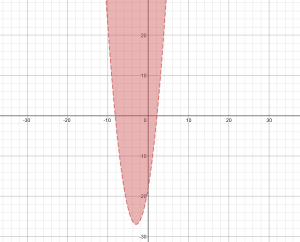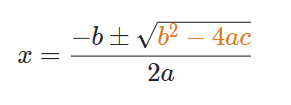Archive of ‘Grade 11’ category
This week was a shortened week so we didn’t go over as much stuff as the previous weeks.
We learned how to graph quadratic and linear inequalities in one variable and two variables.
To graph a quadratic inequality you need to find the y- intercept and the vertex and use the clues given to graph it and find possible solutions and where to shade in the graph.
For example:
y>x^2+6x-18
the y intercept is -18
you can tell it opens up because the x^2 is positive
the vertex moved
and the pattern is 1.3.5 because the leading coefficient is 1
So then you would factor
y>x^2+6x-18
y> (x+8)(x-2)
and with those you can find your vertex from -8 and +2 being your x- intercepts
to find the vertex you would do -8+2/2
so your vertex is -3
and by plugging it back into you equation you can find the minimum point connected to the vertex and graph it

we know that its a doted line because the > doesn’t have a line underneath it
and we can put a test point into the original equation to know if its shaded in, in the certain area.
PreCalc 11
We did review for most of the week so this is one of the things i reviewed today. so i revisited the idea of factoring polynomial expressions like we learned last year in grade 10, and like we learned in the previous units.
For example, when we started the practicing of factoring expressions I remembered that for the second number in the trinomial (abc: letter B) it was the sum of adding the two numbers together and the third number in the trinomial (abc: letter C) was the sum of the two numbers multiplied.
For example:
x2 + 7x + 10
I could go through the list of factors if 10 and then find 2 that add together to get the sum of 7.
1-10
2-5
you notice that 2+5 equals 10 so then you input those into the expression
(x + 2) (x + 5)
This week we continued to go over quadratic functions.
I learned that you could model problems with quadratic equations,
for example: Find two integers with a sum of 24 and the greatest possible product.
x+y= 2
product is a multiplication word so we know that we have to multiply it to find it meaning that the PRODUCT= x ∙ y
we have to re-arrange the equation that we already have so that we can get it to have only one variable.
y= 24-x
product=x ∙ (24-x)
(zero product law)
x=0 (1st term)
x=24 (inside brackets)
LOS= 0+24 divided by 2
=12
then we would insert that into our standard form
p(x)= x (24-x)
p(12)= 12 (24-12)
=144
144 is our maximum product
I found it very interesting that we didn’t need to have a word problem that involves something being thrown or going up nd down like a U shape and that instead we could still help solve it and graph it like one.
This week was a tough week coming back from spring break and my most struggle this week was trying to stay in focus the whole class since we had two weeks off I definitely missed a lot this week because I couldn’t keep in focus, we learned how to graph quadratic equations,
we learned that the vertex is the exact midpoint of the x- intercepts.
the standard form is ax² + bx + c = 0
So for a function to be quadratic it has to have x2 in it, so that it will graph a parabola that will make a U shape on the graph.
The parent function or where all parabolas start is From this form y=x2
we can change the equation so that we can add variables to show if the parabola will be moved up or down, side to side, which way it faces and how skinny or thick it will be.
For example:
y=x2+5
this means the parabola will be 5 up on the y-axis but zero on the x-axis.
7 key characteristics: Vertex (most important), Domain, Range, Maximum/Minimum, x-intercept, y-intercept, and the line of symmetry.
The discriminant is the part of the quadratic formula under the square root.

The discriminant can be positive, zero, or negative, and this determines how many solutions there are to the given quadratic equation.
A positive discriminant indicates that the quadratic has two distinct real number solutions.
A discriminant of zero indicates that the quadratic has a repeated real number solution.
A negative discriminant indicates that neither of the solutions are real numbers.
6×2+10x−1=0
a=6
b=10
c=−1
This week in pre calculus 11 we learned how to solve quadratic equations, which at first the concept was a bit confusing but after working in the workbook started to get much easier because I was starting to see the patterns of the equations and expressions.

Today we actually learned the third way of solving a quadratic equations and with this way it uses a quadratic formula (in image above) and you can take the a,b, and c out of our equations that equal 0. For me it wasn’t to hard to start to understand where you would be inputting these numbers and started putting them in the right spots without even realizing, for me the hardest part was remembering the formula to use.

I learned that it’s better to take the time to look over your steps and do them slower so you avoid mistakes instead of rushing through them and messing up because it is very hard to verify them.
This week in PreCalc 11 we revisited the idea of factoring polynomial expressions like we learned last year in grade 10.
For example when we started the practicing of factoring expressions I remembered that for the second number in the trinomial it was the sum of adding the two numbers together and the third number in the trinomial was the sum of the two numbers multiplied.
For example:
x2 + 7x + 10
I could go through the list of factors if 10 and then find 2 that add together to get the sum of 7.
1-10
2-5
you notice that 2+5 equals 10 so then you input those into the expression
(x + 2) (x + 5)
We also learned what to do when the expression is written like this
9×2 + 6x +1
(when there’s a number in front of the first x)
so the first step that i would do is to start to fill in the box with the numbers that i have so the 9×2 and the 1.

then you would multiply 9×2 by 1 then find the factors of the sum
1-9
3-3
and you can see that the 3-3 equals to 6 so those will be our missing variables

and then you would find what’s common between each line and those would be your expression numbers
( 3x + 1)( 3x + 1)
This week in Pre calculus 11 we learned how to multiply and divide radical expressions.
For multiplying radical expressions we learned and revisited the idea of foil which means (first, outside, inside, last) and that’s the order that you multiply it by. Once you’ve done that you combine the like terms together and start to solve it. I struggled with learning how to simplify the expression once I expanded it, to do that you need to figure out if it can be simplified anymore and if it can you can look for the common factors of it and simplify from there.
For example:

For division we learned how to conjugate an equation to solve it and how to multiply it by a fraction that is the same on the bottom and the top (so it’s multiplied by 1).
Conjugate means that you take the bottom numbers on the equation then put them on the top of a fraction with the same number and multiply the original by that.
for example

This week in Precalc 11 we learned how to simplify radical expressions. We learned about how to write mixed radicals as an entire radical.
An example of this is that you would take a mixed radical and solve it to simplify it.
2 ![\sqrt[2]{7} \sqrt[2]{7}](http://s0.wp.com/latex.php?latex=%5Csqrt%5B2%5D%7B7%7D&bg=ffffff&fg=000000&s=0)
and then the next step is that you would add the 2 underneath it for example under the radical it would look like 2-2-7
then the second step would be to multiply it together which would be 28
so then 2 ![\sqrt[2]{7} \sqrt[2]{7}](http://s0.wp.com/latex.php?latex=%5Csqrt%5B2%5D%7B7%7D&bg=ffffff&fg=000000&s=0) would equal to
would equal to ![\sqrt[2]{28} \sqrt[2]{28}](http://s0.wp.com/latex.php?latex=%5Csqrt%5B2%5D%7B28%7D&bg=ffffff&fg=000000&s=0)
I struggled a lot with the first day of learning how to solve to make it more simple, but once I worked on looking and breaking down what the equation was in my head it ended up being much easier, lately ive struggled with over complicating the questions in my head and then getting them wrong.
This week in pre calculus 11 we learned the other half of our sequence and series, we introduced geometric sequences, we learned that each term is multiplied by a constant, known as the common ratio like in the past week with series it was called the common difference. Tn-1 means the term in front of Tn.
The equation for geometric sequences that we learned was:  and i learned that r could never equal 1
and i learned that r could never equal 1
For me a trick that helped is instead of writing the a1 at the top of the formula i would replace it with t1 because for me looking at the equation it makes more sense because they mean the same thing, i also like to write the common ratio as: CR instead of r so it in my mind it doesn’t look like a variable for a number.
We also learned about finite geometric series which is different from geometric sequences for example
3,13,48,192: is a geometric sequence
3+12+48+192 is a geometric series
In some of the question to find the answers we had to go back to the week before and use the formulas that we learned from the past week using the equation for tn first and then using our new sn equation








